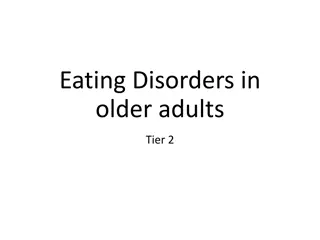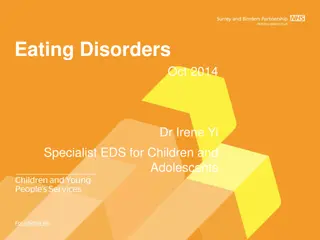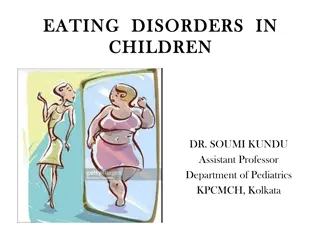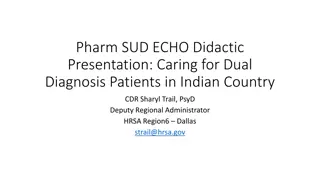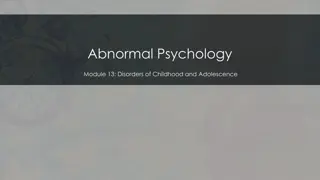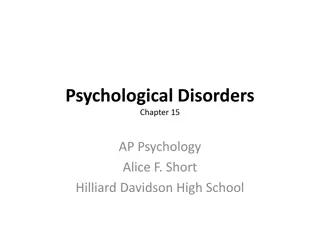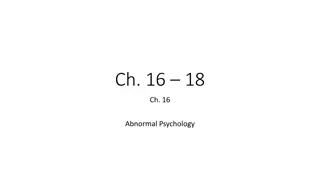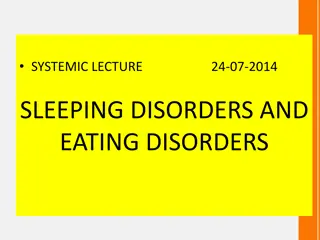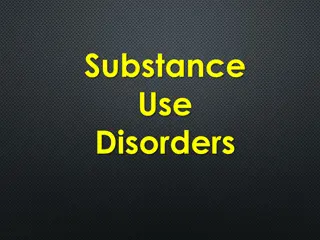Understanding Psychological Disorders and Diagnosis
Explore key concepts like the medical model applied to abnormal behavior, criteria of abnormal behavior, stereotypes of psychological disorders, psychodiagnosis, prevalence of psychological disorders, and a specific focus on anxiety disorders such as generalized anxiety disorder. Learn about different perspectives, classifications, and prevalence rates of mental health conditions.
Download Presentation

Please find below an Image/Link to download the presentation.
The content on the website is provided AS IS for your information and personal use only. It may not be sold, licensed, or shared on other websites without obtaining consent from the author. Download presentation by click this link. If you encounter any issues during the download, it is possible that the publisher has removed the file from their server.
E N D
Presentation Transcript
PSYCHOLOGICAL DISORDERS
MEDICAL MODEL APPLIED TO ABNORMAL BEHAVIOR Medical model proposes that it is useful to think of abnormal behavior as a disease Critics: Thomas Szasz mind can t be sick Diagnosis: distinguish one illness from another Etiology: causation and developmental history of an illness Prognosis: forecast about probable course of an illness
CRITERIA OF ABNORMAL BEHAVIOR Deviance: deviating from society s norms Maladaptive behavior: struggling to adapt Personal distress: usually depression and/or anxiety disorders Evolutionary psychs believe mental disorders should be referred to as evolutionary dysfunctions
STEREOTYPES OF PSYCHOLOGICAL DISORDERS 1) Psych disorders are incurable 2) People w/psych disorders are often violent and dangerous 3) People w/psych disorders behave in bizarre ways and are very different from normal people
PSYCHODIAGNOSIS: CLASSIFICATION OF DISORDERS 1952: Diagnostic and Statistical Manual of Mental Disorders (DSM) describes 100 disorders 1980: DSM-III---new classification system Axes I and II diagnose disorders Axes III-V are supplemental info
PREVALENCE OF PSYCHOLOGICAL DISORDERS Epidemiology: the study of the distribution of mental or physical disorders Prevalence: percentage of population that exhibits a disorder during a specific time period DSM criteria: 1/3 of pop. has some psych disorder
ANXIETY DISORDERS A class of disorders marked by feelings of excessive apprehension and anxiety
GENERALIZED ANXIETY DISORDER DEF: marked by a chronic, high level of anxiety that is not tied to any specific threat Called free-floating anxiety Worry about minor matters Physical symptoms: trembling, muscle tension, diarrhea, dizziness, faintness, sweating, heart palpitations
PHOBIC DISORDERS DEF: marked by a persistent and irrational fear of an object or situation that presents no realistic danger Even imagining the object can trigger anxiety
PANIC DISORDER AND AGORAPHOBIA Panic disorder: characterized by recurrent attacks of overwhelming anxiety that usually occur suddenly and unexpectedly Agoraphobia: fear of going out to public places Majority who suffer from one or both are female
OBSESSIVE-COMPULSIVE DISORDER OCD: marked by persistent, uncontrollable intrusions of unwanted thoughts and urges to engage in senseless rituals Obsessions are thoughts Compulsions are actions
ETIOLOGY OF ANXIETY DISORDERS
BIOLOGICAL FACTORS Concordance rate: indicates the percentage of twin pairs or other pairs of relatives that exhibit the same disorders Anxiety sensitivity Neurotransmitters
CONDITIONING AND LEARNING Anxiety responses are acquired by classical conditioning They are maintained by operant conditioning Phobias could be evolutionary Observational learning may also play a part
COGNITIVE FACTORS Some are more likely to have anxiety b/c they tend to: 1) misinterpret harmless situations as threatening 2) focus excessive attention on perceived threats 3) selectively recall info that seems threatening
PERSONALITY AND STRESS Certain personality traits appear to be related to likelihood of anxiety Neuroticism---nervous, jittery, insecure, guilt- prone, gloomy
SOMATOFORM DISORDERS Physical ailments that cannot be fully explained by organic conditions and are largely due to psychological factors
SOMATIZATION DISORDER DEF: marked by a history of diverse physical complaints that appear to be psychological in origin Usually a very diverse array of symptoms
CONVERSION DISORDER DEF: characterized by a significant loss of physical function (w/no apparent organic basis), usually in a single organ system
HYPOCHONDRIASIS DEF: characterized by excessive preoccupation w/health concerns and incessant worry about developing physical illnesses Usually coupled w/ anxiety disorders and depression
ETIOLOGY OF SOMATOFORM DISORDERS
PERSONALITY FACTORS Histrionic personality most prevalent Self-centered, suggestible, excitable, highly emotional, overly dramatic Neuroticism also common
THE SICK ROLE Being sick is a way to avoid life s challenges Creates an excuse for failure Gets attention from others
DISSOCIATIVE DISORDERS Class of disorders in which people lose contact w/portions of their consciousness or memory, resulting in disruptions in their sense of identity
DISSOCIATIVE AMNESIA AND FUGUE Dissociative Amnesia: sudden loss of memory for important personal info that is too extensive to be due to normal forgetting Dissociative Fugue: loss of memory for entire life along with sense of identity
DISSOCIATIVE IDENTITY DISORDER DID: involves the coexistence in one person of 2 or more largely complete, and usually very different, personalities Personalities usually unaware of each other Alternate personalities exhibit traits unusual for original personality
ETIOLOGY OF DISSOCIATIVE DISORDERS Nicholas Spanos: DID patients are merely role- playing to mask personal failure Trauma does seem to be the main cause of development of DID
MOOD DISORDERS Class of disorders marked by emotional disturbances of varied kinds that may spill over to disrupt physical, perceptual, social, and thought processes
MAJOR DEPRESSIVE DISORDER DEF: show persistent feelings of sadness and despair and a loss of interest in previous sources of pleasure Depression can occur at any point in life Dysthynic disorder: chronic depression that is insufficient in severity to justify diagnosis of a major depressive episode
BIPOLAR DISORDER DEF: characterized by the experience of one or more manic episodes usually accompanied by periods of depression Cyclothymic disorder: exhibit chronic but relatively mild symptoms of bipolar disturbance
ETIOLOGY OF MOOD DISORDERS
GENETIC VULNERABILITY Heredity can create a predisposition Environmental factors may determine if it becomes an actual disorder
NEUROCHEMICAL FACTORS Norepinephrine and serotonin thought to be the main NT s Recent studies are showing that other NT s may be involved
COGNITIVE FACTORS Depression caused by Learned helplessness---a passive giving up People with pessimistic explanatory style are most susceptible to depression Hopelessness theory: pessimistic style, high stress, low self-esteem, etc create depression Basically negative thoughts and emotions lead to and maintain depression
INTERPERSONAL ROOTS Behaviorist approach Inadequate social skills lead to depression Depressed people are depressing








